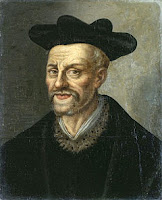The 23rd January seems to be a very French affair:
 |
| Rabelais |
On the 23rd January 1546, having published nothing for eleven years, François Rabelais publishes the Tiers Livre, his sequel to Gargantua and Pantagruel. Rabelais is one of the pioneers of performance writing. The French Renaissance was a time of linguistic controversies. Among the issues debated by scholars was the question of the origin of language. What was the first language? Is language something that all humans are born with or something that they learn? Is there some sort of connection between words and the objects they refer to, or are words purely arbitrary? Rabelais deals with these matters, among many others, in his books.
The early 16th century was also a time of innovations and change for the French language, especially in its written form. The first grammar was published in 1530, followed nine years later by the first dictionary. Since spelling was far less codified than it is now, each author used his own orthography. Rabelais himself developed his personal set of rather complex rules. He was a supporter of etymological spelling, i.e., one that reflects the origin of words, and was thus opposed to those who favoured a simplified spelling, one that reflects the pronunciation of words.
Rabelais then returned to the story of Pantagruel himself in the last three books. The Third Book of Pantagruel (in French, Le tiers-livre de Pantagruel; the original title is Le tiers livre des faicts et dicts héroïques du bon Pantagruel) concerns Pantagruel and his friend Panurge, who spend the entire book discussing with many people the question of whether Panurge should marry; the question is unresolved. The book ends with the start of a sea voyage in search of the oracle of the divine bottle to resolve once and for all the question of marriage.
 |
| Pascal |
It was also on the 23rd January 1656 that Blaise Pascal, French philosopher and theologian, published the first of his Lettres provinciales. The Provincial letters are a series of eighteen letters written by Pascal under the pseudonym Louis de Montalte. Written in the midst of the formulary controversy between the Jansenists and the Jesuits, they are a defense of the Jansenist Antoine Arnauld from Port-Royal-des-Champs, a friend of Pascal who in 1656 was condemned by the Faculté de Théologie at the Sorbonne in Paris for views that were claimed to be heretical. The First Letter letter (3760 words) is dated 23rd January, 1656 and the eighteenth 24th March, 1657. A fragmentary nineteenth letter is frequently included with the other eighteen.
The 23rd January is also the birthday of three rather prominent Frenchmen.
On this day in 1783, the author Stendhal (Marie-Henri Beyle) was born in Grenoble.
In 1832, the painter Édouard Manet was born in Paris,
 |
| Standhal |
 |
| Manet |
And on the 23rd January 1872 the physicist Paul Langevin was also born in Paris. He developed Langevin dynamics and the Langevin equation. He was one of the founders of the Comité de vigilance des intellectuels antifascistes, CVIA, an antifascist organization created in the wake of the 6th February 1934 far right riots. Langevin was also president of the Human Rights League (LDH) from 1944 to 1946 — he had just recently joined the French Communist Party. He is entombed at the Panthéon. Being a public opponent against fascism in the 1930s resulted in his arrest and consequently he was held under house arrest by the Vichy government for most of the war. Paul Langevin, previously a doctoral student of Pierre Curie and later a lover of Marie Curie, is also famous for his two US patents with Chilowski in 1916 and 1917 regarding a systematic ultrasonic submarine detection.
 |
| Langevin |
 |
| Langevin seated middle Einstein seated at left on sideboard |
In 1910 he reportedly had an affair with the then widowed Marie Curie; today, their respective grandson and granddaughter are married to one another: Hélène Langevin-Joliot and Michel Langevin. As a noted and outspoken opponent of Nazism, he was removed from his post by the Vichy government following the occupation of the country by Nazi Germany. He was later restored to his position in 1944. He died in Paris in 1946, two years after living to see the Liberation of Paris. He is buried near several other prominent French scientists in the Pantheon in Paris.
His daughter, Hélène Solomon-Langevin, was arrested for Resistance activity and survived several concentration camps. She was on the same convoy of female political prisoners as Marie-Claude Vaillant-Couturier and Charlotte Delbo.
There is a great family story here, as I said at the beginning, a very French affair.
No comments:
Post a Comment